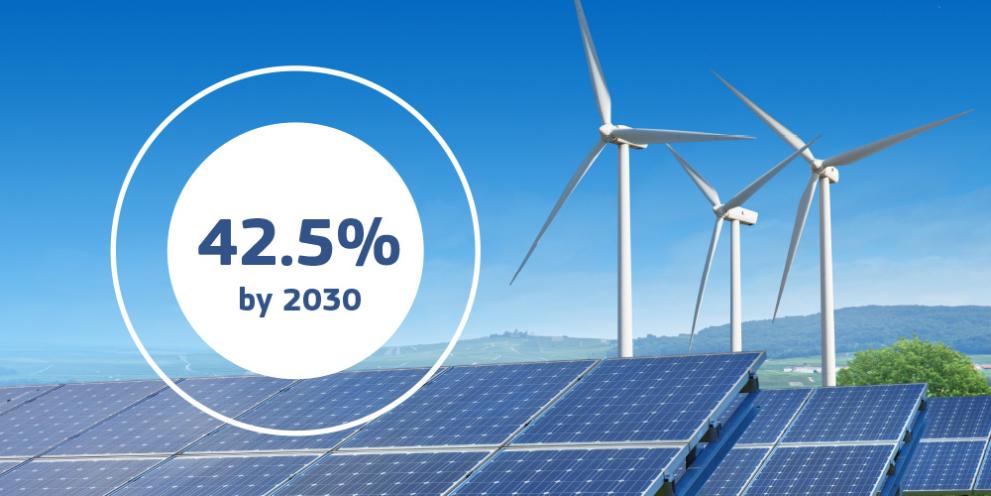The energy sector is responsible for more than 75% of the EU’s greenhouse gas emissions. Increasing the share of renewable energy across the different sectors of the economy is therefore a key building block to reaching the goal of reducing net greenhouse gas emissions by at least 55% by 2030 and becoming a climate-neutral continent by 2050.
Key facts
The 2030 targets
Building on the 20% target for 2020, the recast Renewable Energy Directive 2018/2001/EU established a new binding renewable energy target for the EU for 2030 of at least 32%, with a clause for a possible upwards revision by 2023.
To meet the higher climate ambition, as presented in the European Green Deal in December 2019, further revisions of the directive were needed.
The Commission presented Europe’s new 2030 climate targets, including a proposal for amending the Renewable Energy Directive, on 14 July 2021. It sought to increase the 32% target to at least 40% renewable energy sources in the EU’s overall energy mix by 2030.
On 18 May 2022, the Commission published the REPowerEU plan, which set out a series of measures to rapidly reduce the EU’s dependence on Russian fossil fuels well before 2030 by accelerating the clean energy transition. The REPowerEU plan is based on three pillars: saving energy, producing clean energy and diversifying the EU's energy supplies. As part of its scaling up of renewable energy in power generation, industry, buildings and transport, the Commission proposed to increase the target in the directive to 45% by 2030.
To further accelerate the deployment of renewables, the Council adopted, following a Commission proposal of 9 November 2022, a temporary emergency regulation on 22 December 2022 to speed up permit-granting procedures for renewable projects and facilitate power purchase agreements.
The revised Renewable Energy Directive EU/2023/2413 raises the EU's binding renewable target for 2030 to a minimum of 42.5%, up from the previous 32% target, with the aspiration to reach 45%.
It means almost doubling the existing share of renewable energy in the EU.
The directive entered into force in all EU countries on 20 November 2023.

The 2020 targets
With its Energy 2020 strategy for competitive, sustainable and secure energy (COM/2010/0639), the EU aimed to reduce greenhouse gas emissions by at least 20%, increase the share of renewable energy to at least 20% of consumption and achieve energy savings of 20% or more by 2020. All EU countries should also achieve a 10% share of renewable energy in their transport sector. In their national renewable action plans, they explained how they intended to achieve these goals by 2020.
Every 2 years between 2001 and 2018, EU countries reported on their progress towards the EU's 2020 renewable energy goals and the Commission, based on the national reports and other available data, produced an EU-wide report, giving an overview of renewable energy policy developments in EU countries.
According to Eurostat’s renewable energy statistics from January 2022, the EU overachieved its target in 2020 with a 22% share of gross final energy consumption from renewable sources. The definitive figures, reported by the EU countries under the Regulation of the Governance of the Energy Union in April 2022, confirmed the conclusions of Eurostat and revealed that in 2020, the EU reached a share of 22.1% of renewable energy in gross final energy consumption, thus exceeding the 20% share aimed at under the 2009 Renewable Energy Directive. The detailed assessment at the EU and national level was published in the 2022 Report on the achievement of the 2020 renewable energy targets.
Documents
- Renewable Energy Directive - non-paper on complementary economic modelling (20/06/2022)
- Study - Technical assistance in realisation of the 4th report on progress of renewable energy in the EU (2019)
Related links
- News: EU agrees stronger legislation to accelerate the rollout of renewable energy (30/03/2023)
- Study: Technical assistance in realisation of the 5th report on progress of renewable energy in the EU (2020)
- Energy 2020 - A strategy for competitive, sustainable and secure energy (COM/2010/0639)
- The REPowerEU Plan
- The European Green Deal
- Clean energy for all Europeans package
